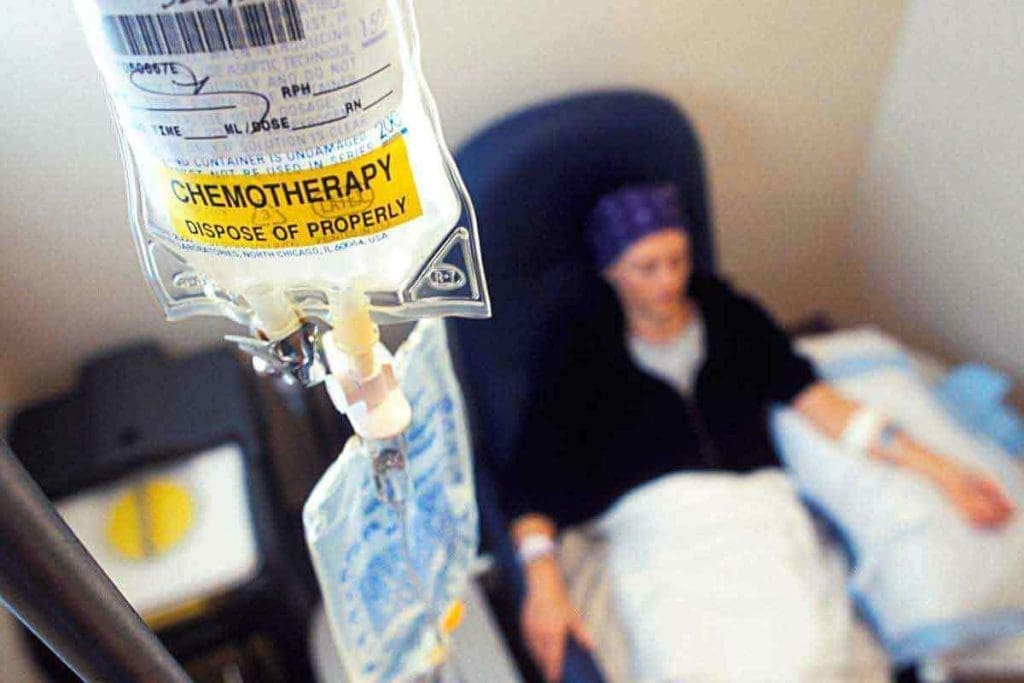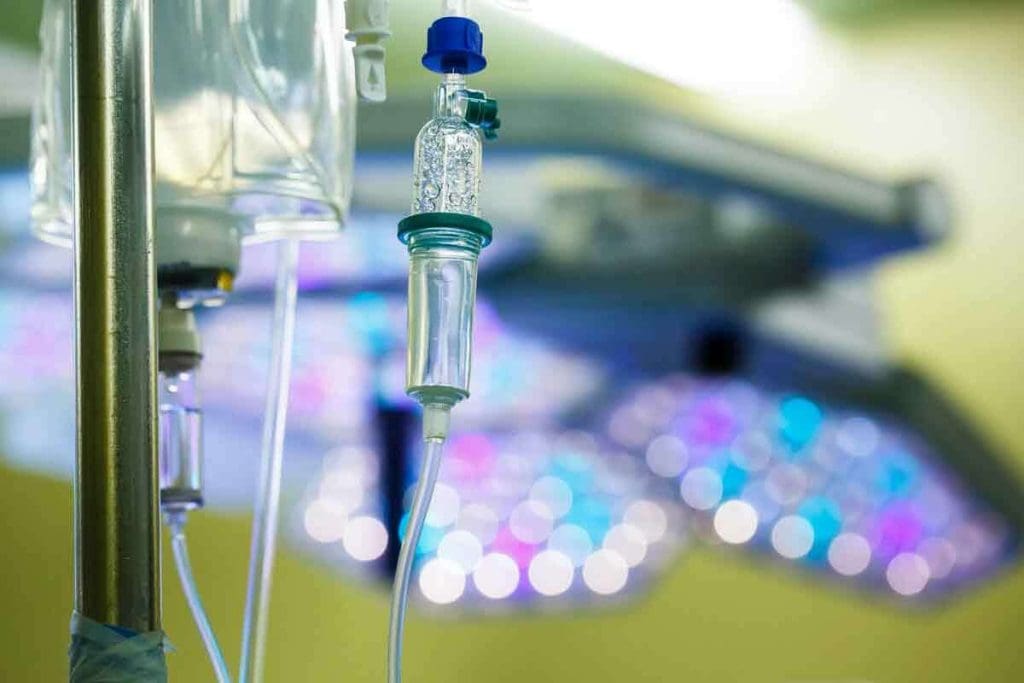Last Updated on November 27, 2025 by Bilal Hasdemir

Chemotherapy is a key part in the battle against cancer. Some drugs are more powerful than others. Aggressive chemotherapy treatments, like doxorubicin (the ‘Red Devil’), cisplatin, and paclitaxel (Taxol), are known for their strong effects against cancer.
These strongest chemo drugs help fight different cancers, including breast cancer. They target and kill cancer cells. But, they also have strong side effects, making treatment tough for patients.
At Liv Hospital, we know how tough aggressive chemotherapy can be. Many patients often ask, what are the strongest chemo drugs used in treatment. We’re dedicated to providing innovative, patient-focused care and using the most effective options to help individuals through their chemotherapy journey.
Key Takeaways
- Aggressive chemotherapy drugs are potent and effective against cancer cells.
- Drugs like doxorubicin and paclitaxel are among the most aggressive chemotherapy treatments.
- These treatments come with significant side effects.
- Liv Hospital offers patient-centered care for those undergoing aggressive chemotherapy.
- Understanding the treatment options is key for patients facing cancer.
Understanding Aggressive Chemotherapy

Aggressive chemotherapy is a key treatment for many cancers. It offers hope to those with tough or resistant tumors. We’ll look at how these treatments work and the balance between their benefits and side effects.
How Potent Chemotherapy Drugs Work
Potent chemotherapy drugs target and kill cancer cells. They stop cancer cells from growing by messing with their cell division. Drugs like Doxorubicin and Cisplatin are known for fighting cancer well.
These drugs work by:
- Stopping DNA replication
- Disrupting cell division
- Causing cells to die naturally
Knowing how these drugs work helps us see their role in fighting cancer. It also shows why we must balance their benefits with their side effects.
Balancing Efficacy and Side Effects
Aggressive chemotherapy is good at treating cancer but can harm healthy cells too. This can lead to side effects like:
- Nausea and vomiting
- Hair loss
- Fatigue
- Higher risk of infections
It’s important to manage these side effects. This way, patients can handle the treatment and keep their quality of life. A recent article on key drugs to watch in oncology talks about new treatments and ways to lessen side effects.
Here’s a table showing the balance between benefits and side effects:
| Chemotherapy Drug | Efficacy | Common Side Effects |
| Doxorubicin | Works well against breast cancer, lymphoma | Can harm the heart, causes hair loss |
| Cisplatin | Good against testicular, ovarian, and lung cancers | Can harm kidneys, nerves |
Healthcare providers choose and dose chemotherapy carefully. This helps make treatments effective while reducing harm. Finding this balance is key to treating cancer well.
What Are the Strongest Chemo Drugs Used Today?

Chemotherapy is a key part of cancer treatment. Some drugs are more effective than others. These drugs are called the strongest because they work well against cancer cells.
Defining “Strength” in Chemotherapy
The strength of a chemotherapy drug is how well it kills cancer cells. It’s measured by how potent it is and how well it works. Alkylating agents are very strong because they damage cancer cells’ DNA, stopping them from growing.
How well a drug works can change based on the cancer type, its stage, and the patient’s health. So, what makes a drug strong can depend on the situation.
Factors That Determine Chemotherapy Potency
Several things make chemotherapy drugs strong. These include:
- The drug’s way of working: How it targets and kills cancer cells.
- Dosing: How often and how much is given.
- Combining drugs: Using more than one drug to fight cancer in different ways.
- Ability to cause cancer cells to die: This is called apoptosis.
Knowing these helps doctors make treatment plans that work best for each patient. This way, they can get good results with fewer side effects.
FDA-Approved Aggressive Chemotherapy Options
The FDA has approved some chemotherapy drugs for their strong action against cancer. Some of these include:
- Doxorubicin: Works well against many cancers, like breast, lymphoma, and leukemia.
- Cisplatin: Treats cancers like testicular, ovarian, lung, bladder, and stomach.
- Cyclophosphamide: An alkylating agent for lymphomas, brain cancer, and some other cancers.
These drugs are very effective but can have big side effects.
Doxorubicin: The Infamous “Red Devil”
Doxorubicin is known as the “Red Devil” because of its bright red color and strong fight against cancer. This powerful drug has been a key part of cancer treatment for many years. It’s often used for breast cancer and other types of cancer.
Why Is Doxorubicin Called the Red Devil?
The drug’s bright red color is why it’s called the Red Devil. This color comes from its chemical makeup. The red color shows the drug’s strength and how well it works. Doctors see this color and know it’s a strong fighter against cancer.
“The red color of doxorubicin is a distinguishing feature that has led to its ominous nickname, reflecting both its potency and the fear it inspires in cancer cells.”
As highlighted by researchers in the field of cancer pharmacology
Mechanism of Action and Cancer-Fighting Properties
Doxorubicin stops DNA from growing by getting in between the strands. This stops cancer cells from growing and leads to their death. It works well against many cancers, like breast cancer, lymphoma, and leukemia. Its ability to kill cancer cells at different stages makes it a powerful drug.
It also creates free radicals that harm cancer cells’ membranes and DNA. This double attack makes it great for fighting tough cancers.
Adriamycin: The Brand Name for Doxorubicin
Doxorubicin is also known as Adriamycin. The name Adriamycin is closely tied to doxorubicin in medical use. Using brand names like Adriamycin helps doctors and patients know they’re getting the right drug.
It’s important for doctors and patients to know the different names and forms of doxorubicin. This ensures the right treatment is given. It also helps manage what to expect from the treatment and its side effects.
Cisplatin: The Platinum-Based Powerhouse
Cisplatin is a key chemotherapy drug used for decades. It’s effective against many cancers, making it a vital part of treatment plans.
Mechanism of Action
Cisplatin binds to cancer cell DNA, stopping them from copying. This platinum-based chemotherapy drug hinders DNA repair, causing cell death. It triggers apoptosis, or programmed cell death, in cancer cells.
A leading oncologist says, “Cisplatin’s action is key to its cancer-fighting power.”
“Cisplatin’s ability to induce apoptosis in cancer cells makes it a valuable tool in the fight against cancer.”
Types of Cancers Treated with Cisplatin
Cisplatin treats several cancers, including:
- Testicular cancer
- Ovarian cancer
- Bladder cancer
- Lung cancer
- Breast cancer
It’s a common chemo drug for breast cancer and other cancers due to its effectiveness.
Managing Side Effects
Cisplatin can cause serious side effects like nephrotoxicity and neurotoxicity. Nephrotoxicity harms the kidneys and can be managed with hydration. Neurotoxicity, or nerve damage, needs careful monitoring and dose adjustments.
We use several strategies to reduce these risks, such as:
- Aggressive hydration to reduce nephrotoxicity
- Dose adjustments to minimize neurotoxicity
- Monitoring for early signs of toxicity
By understanding and managing side effects, we can ensure cisplatin’s benefits while reducing its risks.
Cyclophosphamide: The Versatile Alkylating Agent
Cyclophosphamide has been a key part of chemotherapy for many years. It’s a strong alkylating agent used to fight different cancers. This includes breast cancer, lymphomas, and leukemias.
Mechanism and Applications in Cancer Treatment
Cyclophosphamide works by adding a chemical group to DNA. This stops cancer cells from copying themselves and leads to their death. It’s effective against many tumors.
We often mix cyclophosphamide with other drugs to make it work better.
Cyclophosphamide is used to treat many cancers. These include:
- Breast cancer
- Non-Hodgkin’s lymphoma
- Chronic lymphocytic leukemia
- Ovarian cancer
Dosing Strategies and Combination Therapies
The dose of cyclophosphamide depends on the cancer, the patient’s health, and other factors. It’s often given with other drugs to boost its effect. For example, the AC-T regimen is a common treatment for breast cancer.
| Treatment Regimen | Cancers Treated | Key Drugs |
| AC-T | Breast Cancer | Adriamycin, Cyclophosphamide, Taxol |
| R-CHOP | Non-Hodgkin’s Lymphoma | Rituximab, Cyclophosphamide, Doxorubicin, Vincristine, Prednisone |
| Cyclophosphamide-based | Various Leukemias and Lymphomas | Cyclophosphamide, other agents |
Long-term Risks and Considerations
Cyclophosphamide is effective but comes with risks. These include the chance of getting another cancer, infertility, and heart problems. We must carefully consider these risks and watch patients closely.
It’s important to understand the long-term effects of cyclophosphamide. This helps healthcare providers and patients make better choices about treatment.
Paclitaxel (Taxol): The Plant-Derived Powerhouse
Paclitaxel, also known as Taxol, is a plant-based chemotherapy drug. It has changed how we treat cancers like breast and ovarian. We’ll look into where it comes from, how it works, and its success in fighting these diseases.
Origin and Development of Taxol
Paclitaxel comes from the bark of the Pacific yew tree (Taxus brevifolia). Its discovery in the 1960s was a big step forward in cancer treatment. At first, getting it was hard because of the rare Pacific yew tree and the tricky extraction process.
Scientists and drug companies worked together to develop paclitaxel. Now, it’s made in a way that doesn’t rely as much on natural sources. This makes it easier to get and use in cancer treatment.
How Paclitaxel Disrupts Cancer Cell Division
Paclitaxel messes with microtubules, which are key for cell division. Microtubules help separate chromosomes during cell division. Paclitaxel sticks to microtubules, keeping them from breaking down.
This stops cells from dividing and leads to cancer cell death. By slowing tumor growth, paclitaxel is a powerful tool against cancer.
Effectiveness in Breast and Ovarian Cancers
Paclitaxel is very effective against breast and ovarian cancers. In breast cancer, it’s often paired with other drugs like doxorubicin to boost its power.
| Cancer Type | Paclitaxel Dosage | Combination Therapy | Response Rate |
| Breast Cancer | 175 mg/m ² | Doxorubicin and Cyclophosphamide | 50-60% |
| Ovarian Cancer | 135 mg/m ² | Carboplatin | 60-70% |
In ovarian cancer, paclitaxel is often paired with carboplatin. This combo has led to better survival rates and response rates. Paclitaxel is a key part of many cancer treatments.
Red Devil vs. Taxol: Comparing Two Breast Cancer Giants
Doxorubicin and Paclitaxel are key drugs in fighting breast cancer. They work differently and have various side effects. Knowing these differences helps doctors choose the best treatment for patients.
Differences in Mechanism and Efficacy
Doxorubicin, called the “Red Devil,” stops cancer cells from making DNA and RNA. Paclitaxel (Taxol) stops cell division by stabilizing microtubules. A study in the European Pharmaceutical Review shows both are top earners in cancer therapy.
How well these drugs work depends on the cancer type and stage. Doxorubicin is good for aggressive cancers, while Paclitaxel is best for metastatic cancer. Doctors choose based on the patient’s health and past treatments.
Side Effect Profiles and Quality of Life Impact
Doxorubicin can harm the heart, while Paclitaxel causes neuropathy, hair loss, and muscle pain. The side effects can differ greatly among patients. This means each patient needs a tailored approach to care.
It’s important to manage these side effects to keep patients’ quality of life high. Adjusting doses or using protective agents can help. We must balance the benefits and risks of these treatments for the best patient outcomes.
Sequential and Combination Approaches
Doctors often use Doxorubicin and Paclitaxel together or one after the other. Using them together can be more effective but also increases side effects. Choosing the right approach depends on the cancer and the patient’s health.
For example, a mix of Doxorubicin and Paclitaxel (AC-T) is used for some breast cancers. This combo can be very effective but needs careful management to avoid too many side effects.
Aggressive Combination Chemotherapy Regimens
Aggressive combination chemotherapy regimens are changing cancer treatment for the better. They use many drugs at once to fight cancer more effectively. This method helps reduce side effects and target cancer cells better.
AC-T (Adriamycin, Cyclophosphamide, Taxol)
The AC-T regimen is a mix of Adriamycin, cyclophosphamide, and Taxol. It’s mainly used for breast cancer. This combo is known for shrinking tumors and boosting survival chances. The drugs work together to attack cancer cells more powerfully than alone.
FOLFOX and FOLFIRINOX
FOLFOX and FOLFIRINOX are for colorectal cancer. FOLFOX has folinic acid, fluorouracil, and oxaliplatin. FOLFIRINOX adds irinotecan. These combos have shown great promise in fighting advanced colorectal cancer. Using many drugs helps beat resistance and boost treatment success.
R-CHOP and Other Lymphoma Protocols
R-CHOP is a common treatment for non-Hodgkin lymphoma. It includes rituximab, cyclophosphamide, doxorubicin, vincristine, and prednisone. Rituximab added to CHOP has greatly improved results. Other lymphoma treatments depend on the type and stage.
Managing Intensified Side Effects of Combination Therapy
Combination chemotherapy is very effective but can cause harsh side effects. It’s important to manage these to keep patients’ quality of life good.
“The key to successful combination chemotherapy lies not only in the selection of drugs but also in the effective management of side effects.”
-Specialists note.
We use different methods to lessen side effects. This includes supportive care drugs and lifestyle changes.
Knowing about aggressive combination chemotherapy helps us tailor treatments better. This leads to better outcomes in the battle against cancer.
Conclusion: Balancing Strength and Safety in Modern Chemotherapy
Exploring the strongest chemotherapy drugs today shows us the importance of balance. The right mix of strength and safety is key. This balance affects how well chemotherapy works, depending on the cancer type and stage.
Drugs like Doxorubicin, Cisplatin, Cyclophosphamide, and Paclitaxel are very powerful. They are used to treat different cancers, including breast cancer. Doctors must think carefully about how strong these drugs are and their possible side effects to help patients the most.
Modern chemotherapy has made big steps forward in keeping patients safe while being effective. Healthcare providers use their knowledge to manage how these drugs work. They focus on the right doses and how to reduce side effects.
Our main aim is to treat cancer well and keep patients safe. By improving chemotherapy and finding the right balance, we can help more people around the world.
FAQ
What are the strongest chemotherapy drugs?
The strongest chemotherapy drugs include doxorubicin (Adriamycin), cisplatin, cyclophosphamide, paclitaxel (Taxol), and others. They are known for their potency and effectiveness against various cancers.
Why is doxorubicin called the “Red Devil”?
Doxorubicin is called the “Red Devil” because of its red color and strength. It’s a powerful drug used to treat cancers like breast cancer.
What is the brand name for doxorubicin?
The brand name for doxorubicin is Adriamycin.
How does cisplatin work?
Cisplatin is a platinum-based drug that damages cancer cells’ DNA. This stops them from dividing and growing.
What are the common side effects of cisplatin?
Common side effects of cisplatin include kidney and nerve damage. These need careful management.
What is cyclophosphamide used for?
Cyclophosphamide is used to treat cancers like lymphoma, leukemia, and breast cancer. It’s an alkylating agent.
How does paclitaxel (Taxol) work?
Paclitaxel disrupts microtubules, which are key for cell division. This stops cancer cells from growing.
What is the difference between doxorubicin and paclitaxel?
Doxorubicin and paclitaxel treat breast cancer but work differently. They also have different side effects.
What are some aggressive combination chemotherapy regimens?
Aggressive regimens include AC-T, FOLFOX, FOLFIRINOX, and R-CHOP. These are used to treat various cancers.
How are the side effects of combination chemotherapy managed?
Side effects are managed with supportive care, dose adjustments, and monitoring. This helps patients cope.
What is the most aggressive form of chemotherapy?
The most aggressive chemotherapy varies by cancer type and patient. AC-T and R-CHOP are considered aggressive.
Are there any long-term risks associated with cyclophosphamide?
Yes, cyclophosphamide can cause secondary cancers and infertility. These are long-term risks.
How does doxorubicin compare to Taxol in terms of efficacy?
Doxorubicin and Taxol are both effective against breast cancer. Their effectiveness depends on the patient and cancer specifics
.
References
- Anand, U., Hegde, A., Gokhale, P. C., & Sashidhara, K. V. (2022). Cancer chemotherapy and beyond: Current status, drug development, and future perspectives. Frontiers in Pharmacology, 13, Article 877304. https://www.ncbi.nlm.nih.gov/pmc/articles/PMC10310991/
- Philpot, R. M., & colleagues. (2016). Doxorubicin and cyclophosphamide lead to long-lasting cognitive deficits in female mice: A model for “chemo brain. Behavioural Brain Research, 310, 123“130. https://www.sciencedirect.com/science/article/abs/pii/S0166432816302182






